元件库标准
电子元器件标准精选

电子元器件标准精选电子元器件标准精选收集了以下类别的标准:1.电子元器件综合标准2.半导体器件标准3.集成电路标准4.集成电路卡标准5.电容器与电感器标准6.电阻器与电位器标准7.液晶与电真空器件标准8.压电陶瓷与石英晶体器件标准9.印制电路板与电连接器标准代号标准名称邮价1.电子元器件综合标准G4210《GB/T4210-2001电工术语:电子设备用机电元件》G5597《GB/T5597-99固体电介质微波复介电常数的测试方法》G16523《GB/T16523-96圆形石英玻璃光掩模基板规范》G16524《GB/T16524-96光掩对准标记规范》G16525《GB/T16525-96塑料有引线片式载体封装引线框架规范》G16526《GB/T16526-96封装引线间电容和引线负载电容测试方法》G16527《GB/T16527-96硬面感光板中光致抗蚀剂和电子束抗蚀剂规范》G16595《GB/T16595-96晶片通用网格规范》G16596《GB/T16596-96确定晶片坐标系规范》G16879《GB/T16879-97掩模嚗光系统精密度和准确度的表示准则》G16880《GB/T16880-97光掩模缺陷分类和尺寸定义的准则》G17564.1〈GB/T17564.1-98电气元器件的标准数据元素:定义-原则和方法〉G17564.2〈GB/T17564.2-2000电气元器件的标准数据元素:EXPRESS 字典模式〉G17564.3〈GB/T17564.3-99电气元器件的标准数据元素:维护和确认的程序〉G17564.4《GB/T17564.3-99电气元器件的标准数据元素:IEC标准数据元素》GJ360A《GJB360A-96电子及电子器件试验方法》GJ546A《GJB546A-96电子元器件质量保证大纲》GJ548《GJB548-96微电字器件试验方法和程序》GJ2823《GJB2823-97电子元器件产品出厂平均质量水平评定方法》GJ3404《GJB3404-98电子元器件选用管理要求》GJ4027〈GJB4027-2000军用电子元器件破坏性物理分析方法〉SJ11126《SJ/T11126-97电子元器件用酚醛系包封材料》SJ11153《SJ/T11153—99磁性氧化物制成的PQ磁芯尺寸系列》SJ11165《SJ/T11165—98用于光纤系统的PIN-FIT模块空白详细规范:》SJ11215《SJ/T11215-1999电子元件自动编带机通用规范》2.半导体器件标准G1553〈GB/T1553-97硅和锗体内少数载流子寿命测定〉G1555〈GB/T1555-97半导体单晶晶向测定方法〉G1558〈GB/T1558-97硅中代位碳原子含量红外吸收测量方法〉G4023《GB/T4023-97半导体分立器件:整流二极管》G6217〈GB/T6217-98高低频放大环境额定的双极型晶体管:空白详细规范〉G6218〈GB/T6218-98开关用双极型晶体管:空白详细规范〉G6219〈GB/T6219-981GHz、5W以下的单栅场效应晶体管:空白详细规范:〉G6351〈GB/T6351-98100A以下环境或管壳额定整流二极管:空白详细规范:〉G6352〈GB/T6352-98100A以下环境或管壳额定反向阻断三极闸流晶体管:空白详细规范:〉G6495.1〈GB/T6495.1-96光伏器件:光伏电流—电压特性的测量〉G6495.2〈GB/T6495.2-96光伏器件:标准太阳电池的要求〉G6495.3〈GB/T6495.3-96光伏器件:地面用光伏器件的测量原理〉G6495.4〈GB/T6495.4-96晶体硅光伏器件的I-V实测特性的修正方法〉G6495.5〈GB/T6495.5-97光伏器件:用开路电压法确定光伏器件的等效电池温度〉G6588 G6589《GB/T6589-2002半导体器件:调整二极管和电压基准二极管空白详细规范》G6590 G8646《GB/T8646-98半导体键合铝合金%硅细丝》G8750《GB/T8750-97半导体器件键合金丝》G7149〈GB7149~7150-87开关用双极型晶体管〉G7153《GB/T7153-2002直热式阶跃型正温度系数热敏电阻器:总规范》G7576《GB/T7576-98高频放大管壳额定双极型晶体管:空白详细规范:》G7577《GB/T7577-96低频放大管壳额定双极型晶体管:空白详细规范:》G9535《GB/T9535-98地面用晶体硅光伏组件设计鉴定和定型》G11499《GB/T11499-2001半导体分立元件文字符号》G12560《GB/T12560-99半导体器件分立元件分规范》G12962《GB/T12962-96硅单晶》G12963《GB/T12963-96硅多晶》G12964《GB/T12964-96硅单晶抛光片》G12965《GB/T12965-96硅单晶切割片和研磨片》G16468《GB/T16468-96静电感应晶体管系列型谱》G16822《GB/T16822-97介电晶体介电性能的试验方法》G16894《GB/T16894-97大于100A,环境和管壳额定的整流二极管空白详细规范:》G17007《GB/T17007-97绝缘栅双极型晶体管测试方法》G17008《GB/T17008-97绝缘栅双极型晶体管的词汇及文字符号》G17169《GB/T17169-97硅抛光片和外延片表面质量光反射测试方法》G17170《GB/T17170-97非掺杂半绝缘砷化镓单晶红外吸收测试方法》G18904.1《GB/T18904.1-2002光电子器件纤维光学系统或子系统用带/不带尾纤的光发射或红外发射二极管空白详细规范》G18904.2《GB/T18904.2-2002光电子器件纤维光学系统或子系统用带尾纤的激光二极管模块空白详细规范》G18904.3《GB/T18904.3-2002光电子器件显示用发光二极管空白详细规范》G18904.4《GB/T18904.4-2002光电子器件纤维光学系统用带/不带尾纤的Pin-FET模块空白详细规范》G18904.5《GB/T18904.5-2003光电子器件纤维光学系统或子系统用带/不带尾纤的pin光电二极管空白详细规范》GJ33A《GJB33A-97半导体分立元件总规范》GJ128A《GJB128A-97半导体分立元件试验方法》GJ3157《GJB3157-1998半导体分立器件失效分析方法和程序》GJ3519《GJB3519-99半导体激光二极管总规范》SJ10585《SJ/T10584—94半导体分立器件表面安装器件外形尺寸》SJ11225《SJ/T11225-2000电子元器件详细规范:3DA504型S波段硅脉冲功率晶体管》SJ11226《SJ/T11226-2000电子元器件详细规范:3DA505型L波段硅脉冲功率晶体管》SJ11227《SJ/T11227-2000电子元器件详细规范:3DA98型NPN硅高频大功率晶体管》SJ20756《SJ20756-1999半导体分立器件结构相似性应用指南》SJ20757《SJ20757-1999微波电路系列和品种微波开关系列的品种》SJ20744《SJ20744-1999半导体材料杂质含量红外吸收光谱分析通用导则》SJ20782《SJ20782-2000充气整流管总规范》SJ20784《SJ20784-2000微型杜瓦总规范》SJ20785《SJ20785-2000超辐射发光二极管组件测试方法》SJ20786《SJ20786-2000半导体光电组件总规范》SJ20787《SJ20787-2000半导体桥式整流器热阻测试方法》SJ20788《SJ20788-2000半导体二极管热阻测试方法》SJ20789《SJ20789-2000MOS场效应晶体管热敏参数快速筛选试验方法》J9684《JB/T9684-2000电力半导体器件用散热器选用导则》J10096《JB/T10096-2000电力半导体器件用管壳选用导则》J10097《JB/T10097-2000电力半导体器件用管壳》DB723〈电力半导体器件和半导体变流器标准〉(93电工版)103.50.00DB735〈电力半导体器件标准〉(93电工版)DB795〈电力半导体器件和整流设备标准(1)〉(94电工版) DB827〈电力半导体器件和整流设备标准(2)〉(95电工版) DB827〈电力半导体器件和整流设备标准(3)〉(96电工版) DB887〈电力半导体器件和整流设备标准(4)〉(97电工版) DB930〈电力半导体器件和整流设备标准(5)〉(98电工版) DB982〈电力半导体器件专业卷(1)〉(2000电工版)3.集成电路标准G4377〈GB/T4377-96半导体集成电路电压调整器测试方法和基本原理〉G5965〈GB/T5965-2000集成电路:双极型单片数字集成电路门电路空白详细规范〉G6798《GB/T6798-1996半导体集成电路电压比较器测试方法的基本原理》G8976《GB/T8976-96膜集成电路和混合膜集成电路总规范》G9424《GB/T9424-98半导体器件集成电路:CMOS数字集成电路4000B和4000UB》G16464《GB/T16464-96半导体器件集成电路总则》G16465《GB/T16465-96膜集成电路和混合膜集成电路分规范》G16466《GB/T16466-96膜集成电路和混合膜集成电路空白详细规范》G16878《GB/T16878-97用于集成电路制造技术的检测图形单元规范》G17023《GB/T17023-97HCOMS数字集成电路系列族规范》G17024《GB/T17024-97HCOMS数字集成电路空白详细规范》G17572〈GB/T17572-99半导体CMOS集成电路:4000B和4000UB系列族规范〉G17573〈GB/T17573-99半导体分立元件和集成电路:总则〉G17574〈GB/T17574-99半导体分集成电路:数字集成电路〉G17940《GB/T17940-2000半导体集成电路:模拟集成电路》G18500.1《GB/T18500.1-2001半导体集成电路:线性数字/模拟转换器(DAG)》G18500.2《GB/T18500.2-2001半导体集成电路:线性模拟/数字转换器(ADC)》GJ597A《GJB597A-96半导体集成电路总规范》GJ3203《GJB3233-1998半导体集成电路失效分析程序和方法》SJ10741《SJ/T10741-2000半成品集成电路CMOS电路测试方法的基本原理》SJ10804《SJ/T10804-2000半成品集成电路电平转换器测试方法的基本原理》SJ10805《SJ/T10805-2000半成品集成电路电压比较器测试方法的基本原理》SJ20674《SJ20674-1998微波电路系列和品种微波信号检波器系列的品种》SJ20675《SJ20675-1998微波电路系列和品种微波固态噪声源系列的品种》SJ20676《SJ20676-1998通信对抗固态宽频带功率放大模块通用规范》SJ20677《SJ20677-1998微波集成PIN单刀开关模块通用规范》SJ20678《SJ20678-1998交换网络模块通用规范》SJ20679《SJ20679-1998通信用户接口模块通用规范》SJ20680《SJ20680-1998通信群路接口模块通用规范》SJ20711《SJ20711-1998分步投影曝光机通用规范》SJ20750《SJ20750-1999军用CMOS电路用抗辐射硅单晶片规范》SJ20758《SJ20758-1999半导体集成电路CMOS门阵列器件规范》SJ20759《SJ20759-1999混合集成电路系列与品种DC/DC变换器系列的品种》SJ20802《SJ20802-2001集成电路金属外壳目检标准》SJ20804《SJ20804-2001微波电路系列和品种微波衰减器系列的品种》4.集成电路卡标准G15694.2《GB/T15694.2-2002识别卡发卡者标识:申请和注册规程》G16649.1〈GB/T16649.1-96识别卡带触点的集成电路卡:物理特性〉G16649.2〈GB/T16649.2-96识别卡带触点的集成电路卡:触点尺寸和位置〉G16649.3〈GB/T16649.3-96识别卡带触点的集成电路卡:电信号和传输协议〉G16649.5《GB/T16649.5-2002识别卡带触点的集成电路卡:应用标识符的编号体系》G16649.6〈GB/T16649.6-2001识别卡:行业间数据元〉G16649.8《GB/T16649.8-2002识别卡带触点的集成电路卡:与安全相关的行业间命令》G16649.10《GB/T16649.10-2002识别卡带触点的集成电路卡:同步卡的电信号和复位应答》G16790.1《GB/T16790.1-97金融交易卡:卡的生命周期》G16791.1《GB/T16791.1-97金融交易卡:概念与结构》G17550.1〈GB/T17550.1-98识别卡光记忆卡:物理特性〉G17550.2〈GB/T17550.2-98识别卡光记忆卡:可访问光区域的尺寸和位置〉G17550.3《GB/T17550.3-98识别卡光记忆卡:光属性和特性》G17550.4《GB/T17550.4-2000识别卡光记忆卡:逻辑数据结构》G17551《GB/T17551-98识别卡光记忆卡一般特性》G17552《GB/T17552-98识别卡金融交易卡》G17553.1《GB/T17553.1-98识别卡无触点集成电路卡:物理特性》G17553.2《GB/T17553.2-2000识别卡无触点集成电路卡:耦合区域的尺寸和位置》G17553.3《GB/T17553.3-2000识别卡无触点集成电路卡:电信号和复位规程》G17554《GB/T17554-98识别卡测试方法》G18239《GB/T18239-2000集成电路(IC)卡读写机通用规范》SJ11166《SJ/T11166—98集成电路卡(IC卡)插座总规范》SJ11220《SJ/T11220-2000集成电路卡通用规范:卡片基本规范》SJ11221《SJ/T11221-2000集成电路卡通用规范:行业间交换用命令》SJ11222《SJ/T11222-2000集成电路卡通用规范:测试方法》SJ11230《SJ/T11230-2001集成电路卡通用规范:接口电路基本应用编程接口规范》SJ11231《SJ/T11231-2001集成电路卡通用规范:带触点的IC卡模块》SJ11232《SJ/T11232-2001集成电路卡通用规范:安全规范》CJ166〈CJ/T166-2002建设事业IC卡应用技术〉5.电容器与电感器标准G2693〈GB/T2693-2001电子设备用固定电容器:总规范〉G2900.16《GB/T2900.16-96电工术语:电力电容器》G3615《GB/T3615-99电解电容器用铝箔》G3616《GB/T3616-99电力电容器用铝箔》G5596〈GB/T5596-96电容器用陶瓷介质材料〉G5966〈GB/T5966-96电子设备用固定电容器:1类瓷介固定电容器〉G5967〈GB/T5967-96电子设备用固定电容器:1类瓷介固定电容器评定水平E〉G5968〈GB/T5968-96电子设备用固定电容器:2类瓷介固定电容器〉G5969〈GB/T5969-96电子设备用固定电容器:2类瓷介固定电容器评定水平E〉G6115.1《GB/T6115.1-98电力系统用串联电容器:总则》G6115.2《GB/T6115.2-2002电力系统用串联电容器:串联电容器组用保护设备》G6115.3《GB/T6115.3-2002电力系统用串联电容器:内部熔丝》G6261〈GB/T6261-98电子设备用固定电容器:额定电压不超过3000V的直流电容器〉G6262〈GB/T6262-98额定电压不超过3000V的直流云母固定电容器:评定水平E〉G6916〈GB/T6916-97湿热带电力电容器〉G7209《GB7209-87CD15型固定铝电解电容器》G7332〈GB/T7332-96电子设备用固定电容器第2部分:分规范〉G7333〈GB/T7333-96电子设备用固定电容器第2部分:空白详细规范:〉G7338〈GB/T7338-96电子设备用固定电容器第6部分:分规范〉G9324《GB/T9324-96多片式瓷介电容器》G9325《GB/T9325-96多层片式瓷介电容器:评定水平E》G11024.1《GB/T11024.1-2001标称电压1KV以上交流电力系统并联电容器:总则》G11024.2《GB/T11024.2-2001标称电压1KV以上交流电力系统并联电容器:耐久性》G11024.3《GB/T11024.3-2001标称电压1KV以上交流电力系统并联电容器:保护》G11024.4《GB/T11024.4-2001标称电压1KV以上交流电力系统并联电容器:内部熔丝》G14472《GB/T14472-98抑制电源电磁干扰用固定电容器:分规范》G14473《GB/T14473-98抑制电源电磁干扰用固定电容器:评定水平D》G16467《GB/T16467-96金属化聚乙烯对苯二甲酸酯膜介质直流片式固定电容器》G16512《GB/T16512-96抑制射频干扰固定电容器:总规范》G16513《GB/T16513-96抑制射频干扰固定电容器:分规范》G17206《GB/T17206-98固体与非固体电解质片式铝固定电容器》G17207《GB/T17207-98固体(MnO2电解质片式铝固定电容器:评定水平E)G17208《GB/T17208-98非固体电解质片式铝固定电容器:评定水平E》G17702.1〈GB/T17702.1-99电力电子电容器:总则〉G17702.2〈GB/T17702.2-99电力电子电容器:熔丝〉G17886.1《GB/T17886.1-99标称电压1KV及以下交流电力并联电容器:总则》G17886.2《GB/T17886.2-99标称电压1KV及以下交流电力并联电容器:试验》G17886.3《GB/T17886.3-99标称电压1KV及以下交流电力并联电容器:内部熔丝》G18504〈GB/T18504-2001管形荧光灯和其他放电灯线路用电容器:性能要求〉G18939.1《GB/T18939.1-2003微波炉电容器第1部分:总则》GJ63B《GJB63B-2001有可靠性指标的固定电解质钽电容器:总规范》GJ3516《GJB3516-99铝电解电容器:总规范》J1811《JB18911-92压缩气体标准电容器》DL840《DL/T840-2003高压并联电容器使用技术条件》DL842《DL/T842-2003低压并联电容器装置使用技术条件》DB802〈电力电容器标准(1)〉(94电工版)DB980〈电力电容器专业卷(1)〉(2000电工版)6.电阻器与电位器标准G7154.1《GB/T7154.1-2003直热式阶跃型正温度系数热敏电阻器:限流用》G7154.2《GB/T7154.2-2003直热式阶跃型正温度系数热敏电阻器: 加热元件用》G7154.3《GB/T7154.3-2003直热式阶跃型正温度系数热敏电阻器:浪涌电流用》G7154.4《GB/T7154.4-2003直热式阶跃型正温度系数热敏电阻器:敏感用》G10193《GB/T10193-97电子设备用压敏电阻器:总规范》G10194《GB/T10194-97电子设备用压敏电阻器:浪涌抑制型压敏电阻器》G10195《GB/T10195-97电子设备用压敏电阻器:碳化硅浪涌抑制型压敏电阻器》G10196《GB/T10196-97电子设备用压敏电阻器:氧化锌浪涌抑制型压敏电阻器》G15883《GB/T15883-95电子设备用膜固定电阻网络空白详细规范::评定水平E》G16515〈GB/T16515-96电子设备用电位器:分规范〉G17025《GB/T17025-97单圈旋转功率电位器分规范》G17026《GB/T17026-97单圈旋转功率电位器评定水平E》G17027《GB/T17027-97单圈旋转功率电位器评定水平F》G17028《GB/T17028-97单圈旋转低功率电位器评定水平E》G17029《GB/T17029-97单圈旋转低功率电位器评定水平F》G17034《GB/T17034-97低功率非线绕固定电阻器评定水平F》G17035《GB/T17035-97带散热器的功率型固定电阻器评定水平H》GJ601A《GJB601A-98热敏电阻器总规范》SJ10774《SJ/T10774-2000电子元器件详细规范:RT14型碳膜固定电阻器评定水平E》SJ10775《SJ/T10775-2000电子元器件详细规范:RT14型金属膜固定电阻器评定水平E》SJ10798《SJ/T10798-2000电子元器件详细规范:MF11型直热式温度系数热敏电阻器评定水平》SJ10799《SJ/T10799-2000电子元器件详细规范:MF53-1型直热式负温度系数热敏电阻器评定水平E》SJ10872《SJ/T10872-2000电子元器件详细规范RJ15型金属膜固定电阻器评定水平E》SJ11113《SJ/T11113-1999电子元器件详细规范RJ型金属膜固定电阻器评定水平E》SJ11267《SJ/T11267-2002电子设备用压敏电阻器安全要求》SJ11255《SJ/T11255-2001叠层型片式电感器详细规范》SJ11267《SJ/T11267-2002电子设备用压敏电阻器安全要求》SJ20647《SJ20647-97铂热敏电阻器总规范》SJ20765《SJ20765-1999实验室用28Vd.c电感器总规范》7.液晶与电真空器件标准G4619《GB/T4619-96液晶显示器件测试方法》G2987〈GB/T2987-96电子管参数符号〉G3306《GB/T3306-2001小功率电子管电性能测试方法》G4597《GB/T4597-96电子管词汇》G6255〈GB/T6255-2001空间电荷控制电子管总规范〉G12852〈GB/T12852-2001磁控管总规范〉G12853〈GB/T12853-2001连续波磁控管空白详细规范:〉G18680《GB/T18680-2002液晶显示器用氧化铟锡透明导电玻璃》GJ616A《GJB616A-2001电子管试验方法》SJ198《SJ/T198-2001计数管总规范》SJ10157〈SJ/T10157-2001脉冲磁控管空白详细规范:〉SJ10732《SJ/T10732-2000电子管型号命名方法》SJ11082《SJ/T11082-2000电子管热丝或灯丝电流和电压的测试方法》SJ11152《SJ/T11152—99交流粉末致光显示器件空白详细规范:》SJ11246《SJ/T11246-2001真空开关用陶瓷管壳》SJ11248《SJ/T11248-2001液晶和固态显示器件:液晶显示(LCD)屏空白详细规范》SJ11260《SJ/T11260-2001真空开关管系列》SJ11261《SJ/T11261-2001真空开关管型号命名方法》SJ11249《SJ/T11249-2001计数管空白详细规范》SJ20023《SJ20023-2000行波管总规范》SJ20746《SJ20746-1999液晶材料性能测试方法》SJ20783《SJ20783-2000小型白炽灯泡总规范》8.压电陶瓷与石英晶体器件标准G2414.1《GB/T2414.1-98压电陶瓷材料性能试验方法:圆片径向伸缩振动》G2414.2《GB/T2414.2-98压电陶瓷材料性能试验方法:长条横向伸缩振动》G3241《GB/T3241—98倍频程和分数倍频程滤波器》G3353《GB/T3353-95人造石英晶体使用指南》G3388《GB/T3388-2002压电陶瓷材料型号命名方法》G3389.1《GB/T3389.1-96铁电压电陶瓷词汇》G3389.2《GB/T3389.2-99压电陶瓷纵向压电应变常数的静态测试》G3389.3《GB/T3389.3-99压电陶瓷居里温度TC的测试》G3389.6《GB/T3389.6-97压电陶瓷长方片厚度切变振动模式》G5593〈GB/T5593-96电子元器件结构陶瓷材料〉G6426〈GB/T6426-99铁电陶瓷材料电滞回线的准静态测试方法〉G6427〈GB/T6427-99压电陶瓷振子频率温度稳定性的测试方法〉G6628〈GB/T6628-96人造石英晶体制材〉G12273《GB/T12273-96石英晶体元件质量评定体系规范:总规范》G12864《GB/T12864-97电子设备用压电陶瓷滤波器质量评定:鉴定批准》G12865《GB/T12865-97电子设备用压电陶瓷滤波器质量评定:评定水平E》G16304《GB/T16304-96压电陶瓷电场应变特性测试方法》G16516《GB/T16516-96石英晶体元件质量评定体系规范:能力批准》G16517《GB/T16517-96石英晶体元件质量评定体系规范:鉴定批准》G16528《GB/T16528-96压敏电阻器用氧化锌陶瓷材料》G17190《GB/T17190-97电子设备用压电陶瓷滤玻器:总规范鉴定批准》SJ10707《SJ/T10707—96石英晶体元件—质量评定体系规范第二部分》SJ10708《SJ/T10708—96石英晶体元件—质量评定体系规范第三部分》SJ10709《SJ/T10709-96压电陶瓷蜂鸣片总规范》SJ11136《SJ/T11136-97电子陶瓷二氧化锆材料》SJ11199《SJ/T11199—99压电石英晶体片》SJ11210《SJ/T11210-1999频率达30MHz石英晶体元件负载谐振频率fL和RL的测量方法》SJ11212《SJ/T11212-1999石英晶体元件参数的测量:激励电平相关性(DLD)的测量》SJ11224《SJ/T11224-2000电子元器件详细规范WIW141型螺杆驱动预调电位器评定水平E》SJ11256《SJ/T11256-2001有质量评定的石英晶体振荡器:总规范》SJ11257《SJ/T11257-2001有质量评定的石英晶体振荡器:分规范》SJ11258《SJ/T11258-2001有质量评定的石英晶体振荡器:空白详细规范》SJ20764《SJ20764-1999介电滤波器总规范》9.印制电路板与电连接器标准G1303.1《GB/T1303.1-98环氧玻璃布层压板》G1303.2《GB/T1303.2-2002对三聚氰胺树脂硬质层压板的要求》G1360〈GB/T1360-98印刷电路网格体系〉G4588.1〈GB/T4588.1-96无金属化孔单双面印制板分规范〉G4588.2〈GB/T4588.2-96有金属化孔单双面印制板分规范〉G4588.12《GB/T4588.12-2000预制内层层压板规范》G5130〈GB/T5130-97电气用热固性树脂工业硬质层压板试验方法〉G10244《GB10244-88电视广播接收机用印制板规范》G15157.2《GB/T15157.2-98基本网格2.54mm(0.1in)的印制板用两件式连接器》G16261《GB/T16261-96印制板总规范》G16315《GB/T16315-96印制电路用限定燃烧性的覆铜箔玻璃布层压板》G16317《GB/T16317-96多层印制电路用限定燃烧性的薄覆铜箔玻璃布层压板》G17562.1《GB/T17562.1-98频率低于3MHz的矩形连接器:有质量评定要求的连接器》G18334《GB/T18334-2001有贯穿连接的挠性多层印制板规范》G18335《GB/T18335-2001有贯穿连接的刚性多层印制板规范》G18381《GB/T18381-2001电工用热固性树脂硬质层压板规范:一般要求》G18501.1《GB/T18501.1-2001有质量评定的直流和低频模拟及处理用连接器:总规范》G18501.2《GB/T18501.2-2001有质量评定的圆形连接器分规范》GJ362A《GJB362A-96钢性印制板总规范》GJ2830《GJB2830-1997 挠性和刚性印制板设计要求》GJ2895《GJB2895-97碳纤维复合材料层合板和层合件通用规范》J8149.1〈JB/T8149.1-2000酚醛纸层压板〉J8149.2〈JB/T8149.2-2000酚醛棉布层压板〉SJ10715《SJ/T10715-96无金属化孔单双面印制板能力详细规范》SJ10716《SJ/T10716-96有金属化孔单双面印制板能力详细规范》SJ10717《SJ/T10717-96多层印制板能力详细规范》SJ10723《SJ/T10723-96印制电路辅助文件照相底版指南》SJ11171《SJ/T11171-98无金属化孔单双面碳膜印制板规范》SJ20439《SJ20439-94印制板组装设计要求》SJ20604《SJ20604-96挠性和刚挠印制板总规范》SJ20747《SJ20747-1999热固性绝缘塑料层压板总规范》SJ20748《SJ20748-1999刚性印制板及刚性印制板组件设计标准》SJ20749《SJ20749-1999阻燃性覆铜箔聚四氟乙烯玻璃布层压板详细规范》SJ20766《SJ20766-99面板型和印制线路型检测插口总规范》SJ20779《SJ20779-2000热固性绝缘塑料层压板试验方法》SJ20780《SJ20780-2000阻燃型铝基覆铜层压板规范》SJ20781《SJ20781-2000热固性绝缘塑料层压管、棒总规范》SJ20810《SJ20810-2002印制板尺寸与公差》LY1278〈LY/T1278-98电工层压木板〉。
元件封装库设计规范

文件编号:CHK-WI-JS-00制订部门:技术中心版本版次:A/0生效日期:2012-11-22受控印章:文件修ffiBt目录一、库文件管理41•目的42. 适用范围43. 引用标准44. 术语说明45.库管理方氏56.库元件添加逍程5二、原理图元件建库规范6 1•原理图元件库分类及命名62.原理图图形耍求73.原理图中元件値标注规剧8三、PCB对装建際规范81. PCBM装库分类及命名92. PCB封装图形8*11四、PCBS装焊盘设廿规范111 •通用要求112. AI元件的封装gtm3. DIP元件的封装Sit 124. SMT元件的封装设it 125. 特殊元件的封装设it 131.目的《元件器討芸库设it 规范》(以卞简祢《规范》)力电路元件库、对装库设it 规范文甘。
本文档规 定设it 中需要注恿的一些事坝,目的是便设廿规范化,并通过垢经验固化力规范的方式,为企业内所 有设itiSIO 整、规范、统一的电子元器件图形符号相封装库,U 而实现节省设计时间,编现严品 研发周期,I?低设计差缁率,提高电路设廿水平的目的。
2•埴用范围适用于公司内部研发、生严等各环节中绘制的电子电路原理图、电路板图。
3・引用标准3.1•采用国际电气制图林旌和国家军用规范 3.2. GB/T4728-2007《电气简图用图形符号》 3.3. GB/T7092-1993《半导体集成电路外形尺寸》 3.4. GB7581-1987《半导U 分立器件外形尺寸》3.5. GB/T 15138-1994《膜集成电路和視合集成电路外形尺寸》 3.6. GJB3243-1998《电子元器件表面安装要求》3.7. JESD30-B-2006《半导体器件計装的描述性指定系统》 38 IPC-7351A-2005《表面安装设计和焊盘图形标准的通用要求》4.4. description 简要描述4.5. Component Tpye 器件类璽 4.6. Footprint 真正库封装名称4.7. SorM Footprint 标准或厂家用对装名称 4.8. Footprint path 封芸库路径 4.9. Value 标注4.10. PCB3D 3D 图形名称 4.11. PCB3D path 3D 库路径 4.12. Availability 库存量 4.13. LT 供货期 4.14. Supplier 生产商 4.15. Distributer 舗售商 4.16. Order Information ij 货号 4.17. ManufacturerP/N 物 fl 编码 4.18. RoHS 是否无舟4.19. UL 是否U LUli (尽量加人UL 号) 4.20. Note 备注4.21. SMD: Surface Mount Devices/表面貼装元件° 4.22. RA : Resistor Arrays/排田 °4.23. MELF : Metal electrode face components/金属电机无引找端面元件. 4.24. SOT: Small outline transistor/小外形晶U 管。
Cadence元件库介绍
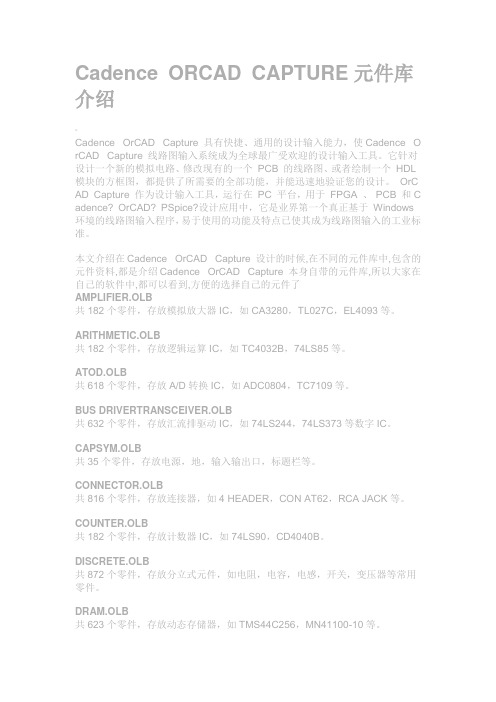
Cadence ORCAD CAPTURE元件库介绍-Cadence OrCAD Capture 具有快捷、通用的设计输入能力,使Cadence O rCAD Capture 线路图输入系统成为全球最广受欢迎的设计输入工具。
它针对设计一个新的模拟电路、修改现有的一个PCB 的线路图、或者绘制一个HDL 模块的方框图,都提供了所需要的全部功能,并能迅速地验证您的设计。
OrC AD Capture 作为设计输入工具,运行在PC 平台,用于FPGA 、PCB 和C adence? OrCAD? PSpice?设计应用中,它是业界第一个真正基于Windows 环境的线路图输入程序,易于使用的功能及特点已使其成为线路图输入的工业标准。
本文介绍在Cadence OrCAD Capture 设计的时候,在不同的元件库中,包含的元件资料,都是介绍Cadence OrCAD Capture 本身自带的元件库,所以大家在自己的软件中,都可以看到,方便的选择自己的元件了AMPLIFIER.OLB共182个零件,存放模拟放大器IC,如CA3280,TL027C,EL4093等。
ARITHMETIC.OLB共182个零件,存放逻辑运算IC,如TC4032B,74LS85等。
ATOD.OLB共618个零件,存放A/D转换IC,如ADC0804,TC7109等。
BUS DRIVERTRANSCEIVER.OLB共632个零件,存放汇流排驱动IC,如74LS244,74LS373等数字IC。
CAPSYM.OLB共35个零件,存放电源,地,输入输出口,标题栏等。
CONNECTOR.OLB共816个零件,存放连接器,如4 HEADER,CON AT62,RCA JACK等。
COUNTER.OLB共182个零件,存放计数器IC,如74LS90,CD4040B。
DISCRETE.OLB共872个零件,存放分立式元件,如电阻,电容,电感,开关,变压器等常用零件。
电子元器件的质量标准及检验方法
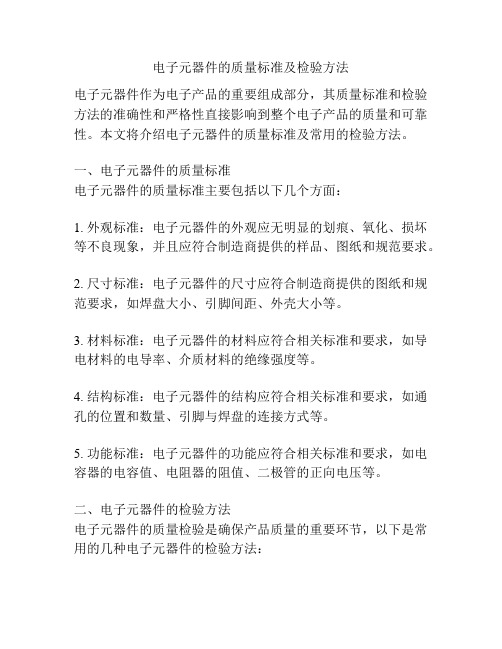
电子元器件的质量标准及检验方法电子元器件作为电子产品的重要组成部分,其质量标准和检验方法的准确性和严格性直接影响到整个电子产品的质量和可靠性。
本文将介绍电子元器件的质量标准及常用的检验方法。
一、电子元器件的质量标准电子元器件的质量标准主要包括以下几个方面:1. 外观标准:电子元器件的外观应无明显的划痕、氧化、损坏等不良现象,并且应符合制造商提供的样品、图纸和规范要求。
2. 尺寸标准:电子元器件的尺寸应符合制造商提供的图纸和规范要求,如焊盘大小、引脚间距、外壳大小等。
3. 材料标准:电子元器件的材料应符合相关标准和要求,如导电材料的电导率、介质材料的绝缘强度等。
4. 结构标准:电子元器件的结构应符合相关标准和要求,如通孔的位置和数量、引脚与焊盘的连接方式等。
5. 功能标准:电子元器件的功能应符合相关标准和要求,如电容器的电容值、电阻器的阻值、二极管的正向电压等。
二、电子元器件的检验方法电子元器件的质量检验是确保产品质量的重要环节,以下是常用的几种电子元器件的检验方法:1. 外观检验:用肉眼检查电子元器件的外观,包括是否有划痕、氧化、变形等不良现象。
2. 尺寸检验:使用量规、卡尺等工具测量电子元器件的尺寸,与制造商提供的图纸和规范要求进行比对。
3. 材料检验:通过仪器测量材料的物理、化学性质,如电导率、绝缘强度等。
4. 结构检验:对电子元器件的结构进行检验,如通孔的位置和数量、引脚与焊盘的连接方式等。
5. 功能检验:使用相应的测试仪器对电子元器件的功能进行测试,如电容器的电容值、电阻器的阻值、二极管的正向电压等。
6. 可靠性测试:对电子元器件进行各种可靠性测试,如高温、低温、湿热、振动等环境试验,以评估元器件在各种工作条件下的可靠性。
以上只是电子元器件质量检验的一部分方法,不同的元器件类型和制造商可能有不同的检验要求和方法。
在实际工作中,还需要参考相关的标准和规范,以确保检验过程的准确性和可靠性。
总结电子元器件的质量标准及检验方法是确保电子产品质量和可靠性的重要保证。
原理图元件库编辑

原理图元件库编辑是电子设计过程中非常重要的一环。本节将介绍元件库编 辑的定义、步骤、常见问题和解决方法,以及提高工作效率的技巧和注意事 项。
定义与重要性
原理图元件库编辑是指在电子设计软件中编辑和管理电子元件的数据库。它 的重要性在于准确和高效地创建和使用元件,从而提高设计质量和工作效率。
总结与结论
原理图元件库编辑是电子设计中不可或缺的步骤,正确和高效地进行元件库编辑可以提高设计质量和工作效率。 借助最佳实践和技巧,设计工作将更加顺利和愉快。
提高工作效率的案例
优化工作环境
创建舒适和高效的工作环境,减 少干扰和浪费的时间。
任务管理
使用任务管理工具和方法,合理 安排工作和提高效率。
时间管理
有效利用时间,设置合理的工作 时间表和优先级。
注意事项和常见误区
数据准确性
确保元件参数的准确性和与设计需求的匹配。
元件一致性
保持元件库中元件的一致性,避免重复和混淆。编辑 Nhomakorabea骤和工具
步骤一
分析设计需求,确定所需元件类型和参数。
步骤三
验证元件的正确性和可用性。
步骤二
使用元件编辑工具创建新元件或修改现有元件。
常用工具
常见的元件库编辑工具包括电子设计软件的内 置编辑器和第三方元件库管理工具。
常见问题及解决方法
1 问题一
元件参数错误或不完整。
3 问题二
元件库缺少特定类型的元件。
2 解决方法
仔细核对元件参数,并参考相关规范和数据 手册。
4 解决方法
使用元件编辑工具创建新的元件,或从可靠 的供应商网站下载符合要求的元件。
最佳实践和技巧
标准化
制定元件库标准,包括命名规 范、参数设置和元件分类。
关键元器件进货检验标准
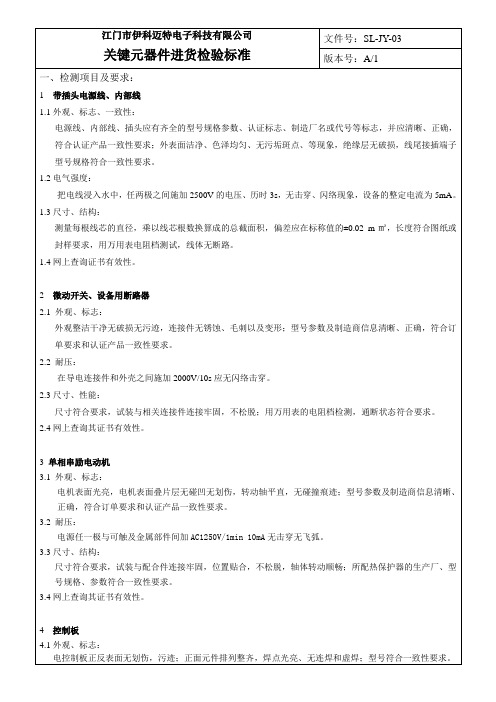
江门市伊科迈特电子科技有限公司关键元器件进货检验标准文件号:SL-JY-03 版本号:A/1一、检测项目及要求:1 带插头电源线、内部线1.1外观、标志、一致性:电源线、内部线、插头应有齐全的型号规格参数、认证标志、制造厂名或代号等标志,并应清晰、正确,符合认证产品一致性要求;外表面洁净、色泽均匀、无污垢斑点、等现象,绝缘层无破损,线尾接插端子型号规格符合一致性要求。
1.2电气强度:把电线浸入水中,任两极之间施加2500V的电压、历时3s,无击穿、闪络现象,设备的整定电流为5mA。
1.3尺寸、结构:测量每根线芯的直径,乘以线芯根数换算成的总截面积,偏差应在标称值的±0.02 m㎡,长度符合图纸或封样要求,用万用表电阻档测试,线体无断路。
1.4网上查询证书有效性。
2 微动开关、设备用断路器2.1 外观、标志:外观整洁干净无破损无污迹,连接件无锈蚀、毛刺以及变形;型号参数及制造商信息清晰、正确,符合订单要求和认证产品一致性要求。
2.2 耐压:在导电连接件和外壳之间施加2000V/10s应无闪络击穿。
2.3尺寸、性能:尺寸符合要求,试装与相关连接件连接牢固,不松脱;用万用表的电阻档检测,通断状态符合要求。
2.4网上查询其证书有效性。
3 单相串励电动机3.1 外观、标志:电机表面光亮,电机表面叠片层无碰凹无划伤,转动轴平直,无碰撞痕迹;型号参数及制造商信息清晰、正确,符合订单要求和认证产品一致性要求。
3.2 耐压:电源任一极与可触及金属部件间加AC1250V/1min 10mA无击穿无飞弧。
3.3尺寸、结构:尺寸符合要求,试装与配合件连接牢固,位置贴合,不松脱,轴体转动顺畅;所配热保护器的生产厂、型号规格、参数符合一致性要求。
3.4网上查询其证书有效性。
4 控制板4.1外观、标志:电控制板正反表面无划伤,污迹;正面元件排列整齐,焊点光亮、无连焊和虚焊;型号符合一致性要求。
4.2 性能及一致性:在试验样机上试用,功能应符合整机性能要求,抗干扰电容、熔断体等关键件符合一致性要求,且证书处于有效状态。
PDMS管道元件库及等级库介绍

¨ (1)显示元件 * 确认SCOM FAEA200HH为当前元件, 点击Display>Component. 因为还没有建立点集和型集,图形中只缺 省显示X、Y、Z轴 * 将Ppoints框选中
PDMS管道元件库及等级库介绍
PDMS管道元件库及等级库介绍
(2) 确认PTSE->FAEA200HH为当前元素 Creat>Point Set>Primitives>Axial P-point(PTAX)
原则:力求形似,比例协调
PDMS管道元件库及等级库介绍
7. 生成材料描述
(1)生成SECTION /TRAIN-MATERIAL,用于存放 材料描述
(2)Creat>Material text
PDMS管道元件库及等级库介绍
6. 生成元件描述文字
用于描述元件的几何形状和特征,在生成等级,生 成材料报表都要用到。 在CATE /FAEA200HH层次下面,生成详细描述 Creat->Detail text
¨ 点集可以被不同直径的一类管件或几类管件共用, 这意味着每一个P-point点相对管件原点的位置必 须是可变的,在这里就要用到之前输入的参数。
PDMS管道元件库及等级库介绍
点集的生成规则
– P0 自动定义为元件的定位点(origin) – P1 元件的入口点 – P2 元件的出口点 – P3 3-Way元件的分支点或阀门的手轮方向
PDMS管道元件库及等级库介绍
¨ 采用编码系统的优点
* 通过有意义的命名为设计带来方便 * 通过命名可以很容易在PDMS层次结构中定位,查找 元件
* 避免重名
* 在管道元件库中,重要的是元件命名和连接 形式代码
标准单元库设计流程

标准单元库设计流程标准单元库是一个关键的设计资源,用于存储和提供可重复使用的电子元件和电路布局。
设计高质量的标准单元库是实现电子设计自动化的关键步骤之一。
下面是标准单元库设计的流程:1. 确定需求:确定标准单元库的目标应用和功能需求。
这需要与设计团队和使用者合作,明确库中元件的类型、性能要求和特性。
2. 元件选择与整理:根据所需功能和性能,从现有的元件库中选择适合的元件,或者根据需要,由设计团队开发新的元件。
对于每个选择的元件,进行完整的整理和记录,包括元件的参数、特性和模型。
3. 元件建模:对于每个选择的元件,进行精确的数学建模和电路仿真。
这些模型可以用于后续的电路设计和验证过程。
4. 元件验证:通过电路仿真和实际的电路测试,验证所选元件的准确性和可靠性。
这些验证步骤有助于评估所选元件是否满足标准单元库的设计要求。
5. 标准单元设计:根据需求,将验证通过的元件组合成标准单元,如逻辑门、存储器单元等。
设计过程需要考虑元件的连接方式、性能和功耗等因素。
6. 标准单元验证:使用标准单元进行电路仿真和测试,以确保设计的正确性和可靠性。
验证过程包括验证标准单元的电气特性和工作在不同工艺、温度和电压条件下的可靠性。
7. 文档编写:为标准单元库中的每个元件和标准单元编写详细的文档。
文档应包括元件或标准单元的规格、特性、接口和使用方法等信息。
8. 批量生产:当标准单元库得到验证并且每个元件和标准单元都有适当的文档时,可以进行批量生产。
生产包括制造所需的芯片和电路板,并对其进行测试和质量控制。
9. 更新和维护:随着技术的进步和新的需求出现,标准单元库需要定期更新和维护。
这包括添加新元件、修改现有元件的参数以及更新文档和验证流程。
以上是标准单元库设计的流程。
通过按照这个流程进行,可以确保标准单元库的质量和可重复使用性,提高电子设计的效率和准确性。
eplan iec标准

eplan iec标准EPLAN是一种先进的电气设计软件,为工程师在电气设计和自动化方面提供了全方位的支持。
IEC标准(国际电工委员会标准)是电气工程领域的国际通用标准,包括电气符号、电气元件、电路图等方面的规范。
本文将介绍EPLAN IEC标准的应用,以及它对电气设计和自动化工程的重要性。
一、EPLAN IEC标准的概述EPLAN IEC标准是基于IEC标准制定的电气设计规范,它为工程师提供了标准化的电气符号和元件信息,以便更加方便、高效地进行电气设计工作。
该标准包括了电气符号的形状、大小、颜色、线宽等要素的规范,以及元件的命名、参数、连接方式等规定。
通过遵守IEC标准,工程师能够实现设计图纸的一致性,减少出错概率,提高工作效率。
二、EPLAN IEC标准的优势1. 提高设计效率:EPLAN IEC标准提供了一套统一的电气符号和元件库,工程师可以直接在设计软件中选择,并进行快速绘制,避免了重复设计和手工绘图的过程,大大提高了设计效率。
2. 确保设计质量:EPLAN IEC标准对电气符号和元件的规范化要求有助于减少错误和遗漏,提高设计的准确性和一致性,确保设计质量。
3. 便于维护和更新:EPLAN IEC标准的使用可以使设计图纸更易于理解和维护,当需要进行更新或修改时,只需要对符号和元件进行相应的更改,而不必对整个图纸进行大幅调整,大大节省了维护和更新的时间和劳力成本。
4. 提供标准化输出:EPLAN IEC标准能够方便地进行标准化输出,生成符合要求的电气图纸和工程文档,并支持自动化生成BOM清单、接线图和电缆线路图等,减少了手动操作的错误和重复性。
三、EPLAN IEC标准的应用案例1. 自动化生产线设计:在自动化生产线的设计中,使用EPLAN IEC 标准能够帮助工程师快速绘制电气图纸,标准化的符号和元件库使得设计一致性高,从而有效提高整个生产线的工作效率和稳定性。
2. 电力系统设计:电力系统的设计是一个复杂的过程,涉及到大量的电气符号和元件。
电气元件库
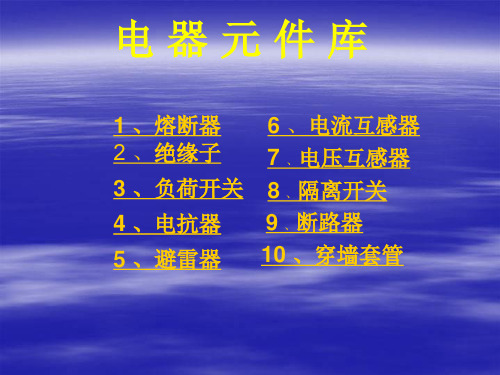
适用于额定电压高于1000V,频率不大于100HZ的交流系统 中运行的电力设备和装置上的户内户外支柱绝缘子.
户外支柱绝缘子.
产品介绍 规格型号:GFWV-40.5 Switch 额定电压:Ur=40.5kV 额定电流:Ir=630;1250;1600 短时耐受:Ik=12.5kA ts=4s 短路关合:31.5kA 破冰厚度:10mm
ZFW-40.5/1250 型户外真空负荷隔离开关主要用于 ① 开断负荷、 过负荷电流及关合负荷电流和短路电流,断开后具有明显的隔离断 口。 ② 该设备与本公司生产的带缺相保护熔断器配合使用,作为 主变压器保护, 替代断路器,降低造价。 能在熔断器一相熔断,
缺相运行时,启动开关实现联动分闸,满足无人值班变电所的运行 要求。 ③ 用于线路上作为分段开关,带负荷分合线路。
ZFN16-12系列交 流高压真空负荷开 关
FN□-24系 列户内交流 高压负荷开 关及熔断器 组合电器
ZFN2112DT630-20、
ZFN21-
12DRT12531.5系列户内 高压真空负荷 开关及熔断器 组合电器
ZFN22-12系列户内交流高压真空负荷开关是在我厂生产的FN5型 开关的基础上,自行开发的新产品。主要适用于额定电压12kv,三 相交流50Hz的电网中,作为开断负荷电流及开关短路电流之用。 产品保留了FN5 开关结构紧凑、安装使用简便的特点,同时配以结 构新颖的专用电动机构,构成手动储能、合闸、的开关合分功能, 是新型环网设计的首选产品,也为原装有FN5开关环网柜直接置换 真空负荷开关提供了最佳方案。
供应商家:上海倍 源工贸有限公司
产品名称: FN1812系列户内高压负 荷开关 型号规 格: 产品类别: 常规产品 -- 高压电 器 -- 负荷开关 参 考价格:厂价直 销 下 浮 数: 产 品品牌:国标产 品 产品产地:上 海 可供数量:批 量
元器件等级标准
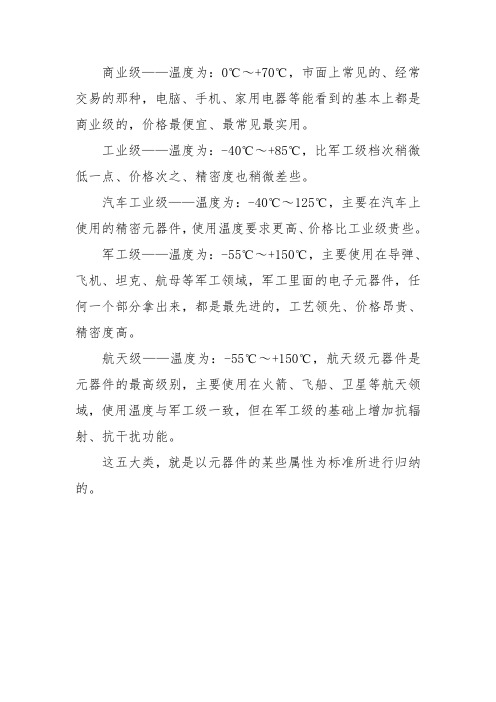
商业级——温度为:0℃~+70℃,市面上常见的、经常交易的那种,电脑、手机、家用电器等能看到的基本上都是商业级的,价格最便宜、最常见最实用。
工业级——温度为:-40℃~+85℃,比军工级档次稍微低一点、价格次之、精密度也稍微差些。
汽车工业级——温度为:-40℃~125℃,主要在汽车上使用的精密元器件,使用温度要求更高、价格比工业级贵些。
军工级——温度为:-55℃~+150℃,主要使用在导弹、飞机、坦克、航母等军工领域,军工里面的电子元器件,任何一个部分拿出来,都是最先进的,工艺领先、价格昂贵、精密度高。
航天级——温度为:-55℃~+150℃,航天级元器件是元器件的最高级别,主要使用在火箭、飞船、卫星等航天领域,使用温度与军工级一致,但在军工级的基础上增加抗辐射、抗干扰功能。
这五大类,就是以元器件的某些属性为标准所进行归纳的。
Multisim 10 元件库

Multisim 10元件库一、Sources(电源库)1.POWER_SOURCES(电源)2.SIGNAL_VOLTAGF_SOURCES(电压信号源)3.SIGNAL_CURRENT SOURCES(电流信号源)4.CONTROL_FUNCTLON_BLOCKS(控制功能模块)5.CONTROLLD_SOURCES(受控电压源)6.CONTROLLED_CURRENT_SORCES(受控电流源)在使用过程中要注意一下几点:(1)交流电源所设置电源的大小皆为有效值。
(2)直流电源的取值必选大于零,大小可以从微伏到千伏,而且没有内阻。
如果它与另一个直流电压源或开关并联使用,必须给直流电压源串联一个电阻。
(3)许多数字器件没有明确的数字接地端,但必须接上地才能正常工作。
用Mul 10进行数字电路仿真时,电路中的数字元件要接上示意性的数字接地端,并且不能与任何器件连接,数字接地端是该电源参考点。
(4)地是一个公共的参考点,电路中所有的电压都是相对于该点的电位差。
在一个电路中,一般来说应当有一个且只能有一个地。
在Mul 10中,可以同时调用多个接地端,但它们的电位都是0V。
并非所用电路都需要接地,但下列情形应考虑接地:○1运算放大器、变压器、各种受控源、示波器、波特图仪和函数发生器必须接地,对于示波器,如果电路中已有接地,示波器的接地端不可接地;○2含模拟和数字元件的混合电路必须接地,可具体分为模拟地和数字地。
(5)V CC电压源常作为没有明确电源引脚的数字器件的电源,它必须放置在电路图上。
V CC电压源还可以用做直流电压源。
通过其属性对话框可以改变电源电压的大小,并且可以是负值。
另外,一个电路只能有一个V CC。
(6)对于除法器,若Y端接有信号,X端的输入信号为0,则输出端变为无穷大或一个很大的电压(高达1.69TV)。
二、Basic(基本元件库)1.BASIC_VIRTUAL(基本虚拟器件)2.RATED_VIRTUAL(额定虚拟器件)3.PACK(排阻)4.SWITCH(开关)5.TRANSFORMER(变压器)6.NONLINEAR_TRANSFORMER(非线性变压器)7.RELAY(继电器)8.CONNERCTOR(连接器)9.SCH_CAP_SYMS(可编辑电路符号)10.SOCKT(插座)11.RESISTOR(电阻)12.CAPACITOR(电容)13.INDUCTOR(电感)14.CAP ELECTROLIT(电解电容)15.VARLABLE_CAPACITO(可变电容)16.VARLABLE_INDUCTOR(可变电感)17.POTENTLONMETER(电位器)三、Diodes(二极管库)1.DIODE VIRTUAL(虚拟二极管)2.DIODE(二极管)3.ZENER(齐纳二极管)4.LED(发光二极管)5.FWB(全波桥式整流器)6.SCHOTTKY_DIODE(肖特基二极管)7.SCR(可控硅整流器)8.DIAC(双向开关二极管)9.TRIAC(三端开关可控硅开关)10.VARACTOR(变容二极管)11.PIN(PIN二极管)四、Transistors(晶体管库)1.TRANSISTORS_VIRTUAL(虚拟晶体管)2.BJT_NPN(NPN晶体管)3.BJT_PNP(PNP晶体管)4.DARLINGTON_NPN(达林顿NPN 晶体管)5.DARLINGTON_PNP(达林顿PNP 晶体管)6.DARLINGTON_ARRAY(达林顿晶体管阵列)7.BJT_NRES(带偏置NPN 型BJT管)8.BJT_PRES(带偏置PNP 型BJT 管)9.BJT_ARRAY(BJT 晶体管阵列)10.IGBT(绝缘栅双极型晶体管)11.MOS_3TDN(三端N 沟道耗尽型MOS管)12.MOS_3TEN(三端N 沟道增强型MOS管)13.MOS_3TEP(三端P 沟道增强型MOS管)14.JFET_N(N沟道JFET)15.JFET_P(P沟道JFET)16.POWER_MOS_N(N沟道功率MOSFET)17.POWER_MOS_P(P沟道功率MOSFET)18.POWER_MOS_COMP(COMP功率MOSFET)19.UJT(单结晶体管)20.THERMAL_MODELS(热效应管)五、Analog(模拟集成元件库)1.ANALOG_VIRTUAL(模拟虚拟器件)2.OPAMP(运算放大器)3.OPAMP_NORTON(诺顿运算放大器)PARATOR(比较器)5.WIDEBAND_AMPS(宽带放大器)6.SPECIAL_FUNCTION(特殊功能运算放大器)六、TTL(TTL元件库)1.74STD_IC2.74STD:是标准TTL集成电路3.74S_IC:是低功耗肖特集成电路4.74S:为肖特基型集成电路5.74LS:为低功耗肖特基型集成电路6.74F:为高速型TTL集成电路7.74ALS:为先进低功耗肖特基型集成电路8.74AS:为先进肖特基型集成电路在使用TTL元件的过程中要注意以下几点:(1)若同一器件有数个不同的封装形式,仿真时,可以随意选择;做PCB板时,必须加以区分。
元件封装库设计规范(初稿)
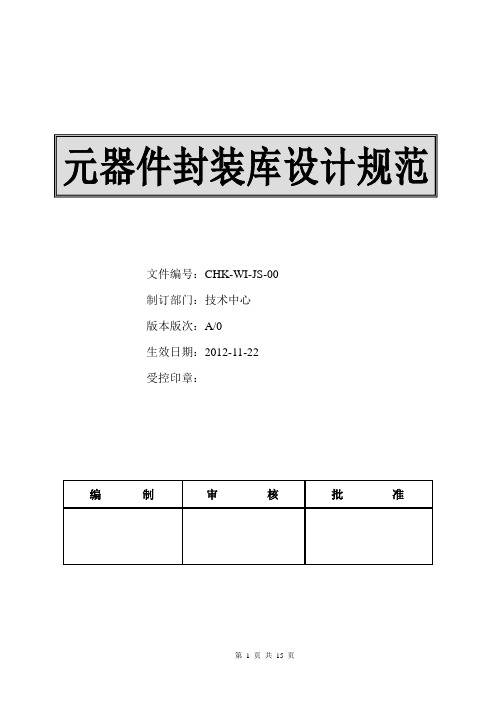
文件编号:CHK-WI-JS-00 制订部门:技术中心版本版次:A/0生效日期:2012-11-22受控印章:文件修订记录目录一、库文件管理 (4)1. 目的 (4)2. 适用范围 (4)3. 引用标准 (4)4. 术语说明 (4)5. 库管理方式 (5)6. 库元件添加流程 (5)二、原理图元件建库规范 (6)1. 原理图元件库分类及命名 (6)2. 原理图图形要求 (7)3. 原理图中元件值标注规则 (8)三、PCB封装建库规范 (8)1. PCB封装库分类及命名 (8)2. PCB封装图形要求 (10)四、PCB封装焊盘设计规范 (11)1.通用要求 (11)2. AI元件的封装设计 (11)3. DIP元件的封装设计 (11)4. SMT元件的封装设计 (12)5.特殊元件的封装设计 (13)一、库文件管理1. 目的《元件器封装库设计规范》(以下简称《规范》)为电路元件库、封装库设计规范文档。
本文档规定设计中需要注意的一些事项,目的是使设计规范化,并通过将经验固化为规范的方式,为企业内所有设计师提供完整、规范、统一的电子元器件图形符号和封装库,从而实现节省设计时间,缩短产品研发周期,降低设计差错率,提高电路设计水平的目的。
2. 适用范围适用于公司内部研发、生产等各环节中绘制的电子电路原理图、电路板图。
3. 引用标准3.1. 采用和遵循最新国际电气制图标准和国家军用规范3.2. GB/T 4728-2007《电气简图用图形符号》3.3. GB/T 7092-1993《半导体集成电路外形尺寸》3.4. GB7581-1987《半导体分立器件外形尺寸》3.5. GB/T 15138-1994《膜集成电路和混合集成电路外形尺寸》3.6. GJB3243-1998《电子元器件表面安装要求》3.7. JESD30-B-2006《半导体器件封装的描述性指定系统》3.8. IPC-7351A-2005《表面安装设计和焊盘图形标准的通用要求》4. 术语说明4.1. Part Number 类型系统编号4.2. Library Ref 原理图符号名称4.3. Library Path 原理图库路径4.4. description 简要描述4.5. Component Tpye 器件类型4.6. Footprint 真正库封装名称4.7. SorM Footprint 标准或厂家用封装名称4.8. Footprint path 封装库路径4.9. Value 标注4.10. PCB 3D 3D图形名称4.11. PCB 3D path 3D库路径4.12. Availability 库存量4.13. LT 供货期4.14. Supplier 生产商4.15. Distributer 销售商4.16. Order Information 订货号4.17. ManufacturerP/N 物料编码4.18. RoHS 是否无铅4.19. UL 是否UL认证(尽量加入UL号)4.20. Note 备注4.21. SMD: Surface Mount Devices/表面贴装元件。
电子元器件检验标准

《电子元器件进货检验标准》一、芯片1)目视检查,来料包装应完好无破损,标识清晰。
2)封装正确,引脚完整,无断裂,无明显歪斜。
3)表面不可有油污,水渍及其它脏物。
由运输材料引起而且能够被空气吹走的灰尘是可被接收的。
4)抽取该批次的2到3块芯片使用,确保功能正常。
二、电阻1)目视检查,来料包装应完好无破损,标识清晰;2)色环颜色清晰易于辨认,色环颜色与标称阻值相符,引脚无氧化、发黑;数字标注正确。
3)阻值与色环标识一致。
4)电阻无断裂,涂覆层脱落;5)表面不可有油污、水渍及其它脏物。
由运输材料引起而且能够被空气吹走的灰尘是可被接收的。
6)用万用表测量阻值。
7)用30W 或40W 的电烙铁对电阻器的引脚加锡,焊锡应能完全包裹住引脚为合格。
三、电容1)目视检查,来料包装应完好无破损,标识清晰;2)印字清晰,容量标识与标称容值相符短引脚端的PVC 封膜上应有“-” 标记,为电容负极,长引脚为正极;引脚无氧化、发黑;3)电容无断裂无破裂,无涂覆层脱落,(电解电容)电解液无漏出。
4)表面不可有油污、水渍及其它脏物。
由运输材料引起而且能够被空气吹走的灰尘是可被接收的。
5)用万用表测量容值。
6)用30W或40W 的电烙铁对电容的引脚加锡,焊锡应能完全包裹住引脚为合格。
四、电感1) 目视检查,来料包装应完好无破损,标识清晰;2) 电感无断裂,涂覆层脱落;3) 表面不可有油污、水渍及其它脏物。
由运输材料引起而且能够被空气吹走的灰尘是可被接收的。
4) 抽取该批次的2 到3 块芯片使用,确保功能正常。
五、电桥1) 目视检查,来料包装应完好无破损,标识清晰;2) 封装要光洁,无缺陷,无批锋;引脚无氧化,无机械损伤等现象。
3) 表面不可有油污、水渍及其它脏物。
由运输材料引起而且能够被空气吹走的灰尘是可被接收的。
4) 抽取该批次的2到3块芯片使用,确保功能正常。
六、二极管1) 目视检查,来料包装应完好无破损,标识清晰;2) 印字清晰,引脚无氧化、发黑;3) 二极管本体无断裂,涂覆层脱落;4) 表面不可有油污、水渍及其它脏物。
proteus元件库 (2)

Proteus元件库简介Proteus是一种基于电子电路仿真软件,广泛用于电子工程领域,特别是用于电路设计和仿真。
它包含了丰富的元件库,可以模拟各种电子元器件的特性和行为。
Proteus元件库是Proteus软件中用于构建电路的元件的集合。
通过使用这些元件,用户可以创建不同类型的电路,并进行仿真和验证。
Proteus元件库包含了各种类型的元件,包括集成电路、模拟电路、数字电路等。
Proteus元件库的分类Proteus元件库可以根据其功能和特性进行分类。
以下是一些常见的Proteus元件库分类:1. 模拟元件库模拟元件库包含了各种类型的模拟电子元器件,如电阻、电容、电感、二极管、晶体管等。
这些元件模拟了真实世界中的电路组件,并提供了各种参数和特性。
用户可以通过选择适当的元件来构建模拟电路,并进行仿真和测试。
2. 数字元件库数字元件库包含了各种类型的数字电子元器件,如逻辑门、寄存器、计数器等。
这些元件可用于构建数字电路,并模拟数字电路中的不同逻辑和时序。
用户可以通过选择适当的元件和连接方式来设计和测试数字电路。
3. 模拟IC元件库模拟IC元件库包含了各种类型的模拟集成电路元件,如运放、比较器、滤波器等。
这些元件提供了更高级别的功能和特性,可用于构建复杂的模拟电路。
用户可以通过选择适当的元件和参数来设计和仿真模拟IC电路。
4. 数字IC元件库数字IC元件库包含了各种类型的数字集成电路元件,如微处理器、存储器、接口芯片等。
这些元件用于构建数字系统和计算机系统,并模拟数字电路中的不同逻辑和数据流。
用户可以通过选择适当的元件和连接方式来设计和测试数字IC电路。
5. 库元件库库元件库包含了一些常用的标准库元件,如电源、连接器、开关等。
这些元件用于构建电路的常规部分,并提供了通用的功能和特性。
用户可以通过选择适当的元件来快速构建电路,并进行仿真和测试。
Proteus元件库的使用在Proteus软件中,使用元件库非常简单。
stdcell library pmk 指标 -回复
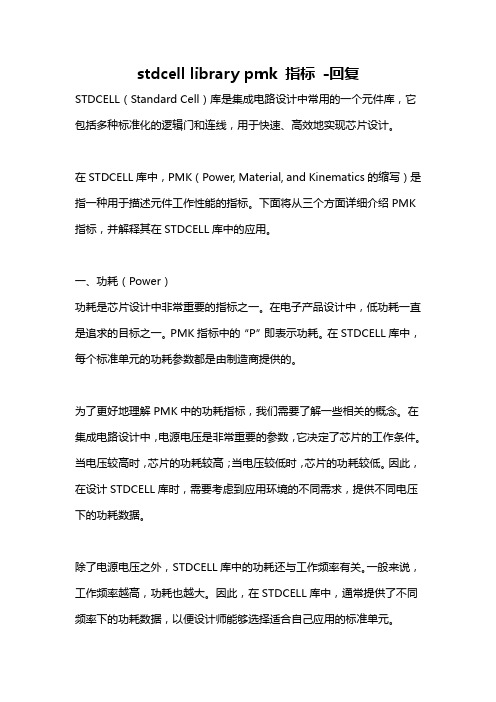
stdcell library pmk 指标-回复STDCELL(Standard Cell)库是集成电路设计中常用的一个元件库,它包括多种标准化的逻辑门和连线,用于快速、高效地实现芯片设计。
在STDCELL库中,PMK(Power, Material, and Kinematics的缩写)是指一种用于描述元件工作性能的指标。
下面将从三个方面详细介绍PMK 指标,并解释其在STDCELL库中的应用。
一、功耗(Power)功耗是芯片设计中非常重要的指标之一。
在电子产品设计中,低功耗一直是追求的目标之一。
PMK指标中的“P”即表示功耗。
在STDCELL库中,每个标准单元的功耗参数都是由制造商提供的。
为了更好地理解PMK中的功耗指标,我们需要了解一些相关的概念。
在集成电路设计中,电源电压是非常重要的参数,它决定了芯片的工作条件。
当电压较高时,芯片的功耗较高;当电压较低时,芯片的功耗较低。
因此,在设计STDCELL库时,需要考虑到应用环境的不同需求,提供不同电压下的功耗数据。
除了电源电压之外,STDCELL库中的功耗还与工作频率有关。
一般来说,工作频率越高,功耗也越大。
因此,在STDCELL库中,通常提供了不同频率下的功耗数据,以便设计师能够选择适合自己应用的标准单元。
二、材料(Material)PMK指标的“M”代表材料。
在STDCELL库中,材料指标主要与制造工艺相关。
为了确保芯片的稳定性和可靠性,制造商使用了特殊的材料。
这些材料对芯片的性能和功耗都有着重要的影响。
在STDCELL库中,常见的材料指标包括:1. 金属层:集成电路中的连线由金属层构成。
不同金属层的导电性能和电荷容量也会对芯片的功耗和性能产生影响。
2. 衬底材料:衬底是整个芯片的基础,不同的衬底材料也会影响芯片的性能和特性。
3. 晶体管材料:晶体管是芯片中最基本的构建单元,晶体管的材料选择对芯片的性能和功耗有着重要的影响。
除了上述材料指标外,STDCELL库中还会提供其他与材料相关的参数,以便设计师能够更好地了解标准单元的性能和特性。
三星481贴片机元件库详解
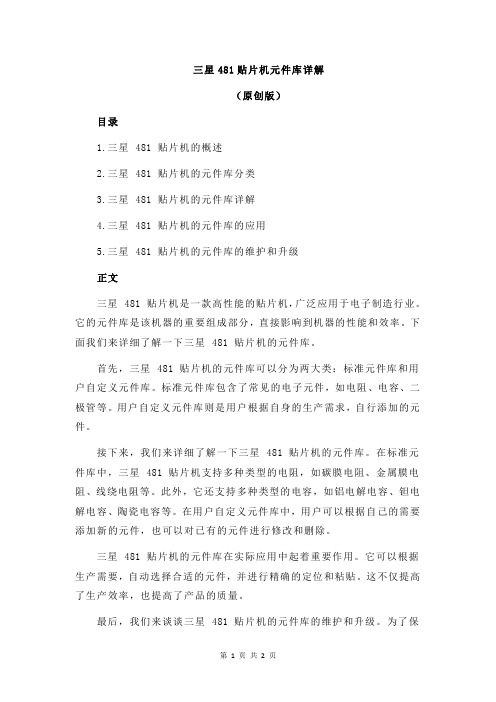
三星481贴片机元件库详解(原创版)目录1.三星 481 贴片机的概述2.三星 481 贴片机的元件库分类3.三星 481 贴片机的元件库详解4.三星 481 贴片机的元件库的应用5.三星 481 贴片机的元件库的维护和升级正文三星 481 贴片机是一款高性能的贴片机,广泛应用于电子制造行业。
它的元件库是该机器的重要组成部分,直接影响到机器的性能和效率。
下面我们来详细了解一下三星 481 贴片机的元件库。
首先,三星 481 贴片机的元件库可以分为两大类:标准元件库和用户自定义元件库。
标准元件库包含了常见的电子元件,如电阻、电容、二极管等。
用户自定义元件库则是用户根据自身的生产需求,自行添加的元件。
接下来,我们来详细了解一下三星 481 贴片机的元件库。
在标准元件库中,三星 481 贴片机支持多种类型的电阻,如碳膜电阻、金属膜电阻、线绕电阻等。
此外,它还支持多种类型的电容,如铝电解电容、钽电解电容、陶瓷电容等。
在用户自定义元件库中,用户可以根据自己的需要添加新的元件,也可以对已有的元件进行修改和删除。
三星 481 贴片机的元件库在实际应用中起着重要作用。
它可以根据生产需要,自动选择合适的元件,并进行精确的定位和粘贴。
这不仅提高了生产效率,也提高了产品的质量。
最后,我们来谈谈三星 481 贴片机的元件库的维护和升级。
为了保证元件库的正常运行,用户需要定期对其进行维护,包括清洁、检查和更换磨损的元件等。
此外,用户还可以根据生产需要,对元件库进行升级,以提高机器的性能和效率。
总的来说,三星 481 贴片机的元件库是该机器的重要组成部分,对于机器的性能和效率有着重要的影响。
- 1、下载文档前请自行甄别文档内容的完整性,平台不提供额外的编辑、内容补充、找答案等附加服务。
- 2、"仅部分预览"的文档,不可在线预览部分如存在完整性等问题,可反馈申请退款(可完整预览的文档不适用该条件!)。
- 3、如文档侵犯您的权益,请联系客服反馈,我们会尽快为您处理(人工客服工作时间:9:00-18:30)。
0.65 0.50 0.40
7.10 7.10 7.10
14 14 14
Note: An Odd Pin Qty = Thermal Tab in Center
P
L
LAND PATTERN NAMING CONVENTION
SOP = Small Outline Package Pitch = Two places past both sides of the decimal point followed by a “P” (50P = 0.50mm)
LAND PATTERN ORIGIN
The land pattern origin is the component “Center of Gravity” so in most cases it’s the Center of the library part. An example of where it’s not the center is the DPAK or TO-252 component.
PLACEMENT COURTYARD
The primary use of the placement courtyard was to provide the PCB designer a guideline for placing land patterns next to each other with enough room to compensate for component tolerances.
G
HEEL
G Z
TOE
SIDE
Z
Explain LP Calculator Min / Max for “T” & impact on “G”
SOLDER JOINT ANALYSIS
Solder Joint Toe, Heel and Side Goal
The chart below provides an example of the Gull Wing component lead Solder Joint Goal
JEDEC Component Lead Forms
SOLDER JOINT TOLERANCE
Component Lead Space Tolerance
This Solder Joint Tolerance is for the inside dimension between the component terminal. It is normally represented by the “S” symbol. This is used to calculate the “HEEL” solder joint.
STANDARDS ORGANIZATIONS
World Standard CAD Library
LAND PATTERN NAMING CONVENTION
Family SO SOP Pitch 1.27 0.80 Lead Span 7.10 7.10 Pin Qty 14 14
SOP SOP SOP
SOLDER JOINT ANALYSIS
Solder Joint / Land Protrusion
MANUFACTURING TOLERANCE
Fabrication Tolerances Assembly Tolerances Component Terminal Tolerances
Presented By: Tom Hausherr
Director of Technology PCB Libraries, Inc.
Tom.Hausherr@
INTRODUCTION
Every electronic component requires a solder land pattern for PCB layout. The solder pattern can be placed into two categories….. 1. Meet all the industry standard requirements for the sole purpose of electronic product automation.
The silkscreen can be drawn by the PCB designer very complex to illustrate their creative talent or very simple. In the end, it really doesn’t matter because you can only see it when the physical PC board passes between the fabrication facilities to the assembly shop. Once the parts are assembled, all the silkscreen outlines are covered up and cannot be seen. When PCB designers start to use all the principles discussed in this outline, the manufacturing assembly process can be fully automated and silkscreen component outlines will not be required.
Describe “Duplication” of Fabrication Tolerance
Solder Joint Goals
ZERO COMONENT ORIENTATION
The Component Zero Orientation relates to the Pick & Place machine tape and reel and component tubes. The rotation of the actual component in the tube or tape & reel is referred to as the Zero Orientation for the CAD Library part and how it should be built in the CAD library. All CAD Library parts should be built in the CAD system in the same rotation that the component is packaged in the tape and reel or assembly feeder tube. The JEDEC JEP95 & EIAJ 481 are the industry guidelines for component packaging information and Component Zero Orientation.
The CAD Library of the Future
What PCB Designers need to know about building CAD Library Parts that will help automate the future of all Electronic Product Development
ZERO COMONENT ORIENTATION
1 2
1) Chip Capacitors, Resistors and Inductors – Pin 1 on Left 2) Molded Capacitors, Resistors and Inductors – Pin 1 (Positive or Cathode) on Left 3) MELF Resistors and Diodes – Pin 1 (Positive or Cathode) on Left 4) SOT Devices (SOT23, SOT223, SOT89, SOT143) – Upper Left 5) TO252 & TO263 (DPAK Type) Devices – Upper Left 6) Small Outline Gullwing ICs (SOIC, SOP, TSOP, SSOP) – Upper Left 7) Ceramic Flat Packs (CFP) – Pin 1 Upper Left 8) Small Outline J Lead ICs (SOJ) – Pin 1 Upper Left 9) Quad Flat Pack ICs (PQFP, SQFP) – Pin 1 Upper Left 10) Ceramic Quad Flat Packs (CQFP) – Pin 1 Upper Left 11) Bumper Quad Flat Pack ICs (BQFP) – Pin 1 Top Center 12) Plastic Leaded Chip Carriers (PLCC) – Pin 1 Top Center 13) Leadless Chip Carriers (LCC) – Pin 1 Top Center 14) Quad Flat No-Lead ICs (QFN) – Pin 1 Upper Left 15) Ball Grid Arrays (BGA) – Pin A1 Upper Left
2. Fail to meet the industry standard requirements and create electronic product creation chaos.
INTRODUCTION
The CAD Library of the Future will be a “One World Standard Library” that will be accepted by the electronics industry to eliminate duplication of effort and automate all of the engineering, PCB design layout, and the manufacturing and assembly processes. The following pages explain the criteria needed to create “The CAD Library of the Future”. But first, let’s meet the key players whose goal is to standardize the electronics product development industry.
